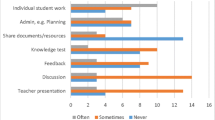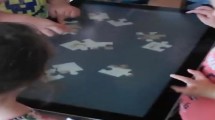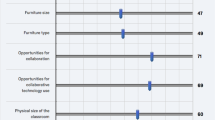Abstract
The benefits of collaborative learning are well documented. However, most of the research has been done with children beyond the ages of early childhood. This could be due to the common and erroneous belief that young children have not developed the capacity to work collaboratively toward a given aim. In this paper we show how small group co-located collaborative learning on a single display computer improves oral language, logical-mathematical and social skills in pre-school children. Considering that early childhood teachers have a responsibility to provide a supportive environment, teacher mediation is essential in order to achieve collaborative learning. Thus, teachers were trained in the use of the technology and strategies for effective collaborative learning. The study was implemented in 10 kindergarten classrooms with 268 children between the ages of 5 and 6 years old. A group of 5 kindergarten classrooms with equivalent characteristics participated as a comparison group. During the four-month intervention, children worked on collaborative activities at least twice a week. A quasi-experimental approach was used to assess the implementation, including pre- and post-testing. The data showed differences in the learning of oral language, logical-mathematical and social skills, with the experimental group demonstrating significantly greater achievement.


Similar content being viewed by others
Explore related subjects
Discover the latest articles, news and stories from top researchers in related subjects.References
Astington, J. W., & Pelletier, J. (2005). Theory of mind, language, and learning in the early years: Developmental origins of school readiness. In B. D. Homer & C. Tamis-LeMonda (Eds.), The development of social cognition and communication (pp. 205–230). Mahwah, N.J.: Lawrence Erlbaum Associates.
Battistich, V., & Watson, M. (2003). Fostering social development in preschool and the early elementary grades through co-operative classroom activities. In R. M. Gillies & A. F. Ashman (Eds.), Co-operative learning: The social and intellectual outcomes of learning in groups. London; New York: Routledge Falmer.
Bellei, C., Valenzuela, J. P., & Sevilla, A. (2009). Working conditions and teachers’ status in a market oriented educational system. The case of Chile. In 10th UKFIET International Conference on Education and Development: Politics, Policies and Progress. Oxford, UK.
Bricker, L. J., Tanimoto, S. L., Rothenberg, A. I., Hutama, D. C., & Wong, T. H. (1995) Multiplayer activities that develop mathematical coordination. In The first international conference on Computer support for collaborative learning (pp. 32–39). Indiana University, Bloomington, Indiana, United States: L. Erlbaum Associates Inc.
Broadhurst, K., Paton, H., & May-Chahal, C. (2005). Children missing from school systems: Exploring divergent patterns of disengagement in the narrative accounts of parents, carers, children and young people. British Journal of Sociology of Education, 26(1), 105–119.
Callaghan, T., Moll, H., Rakoczy, H., Warneken, F., Liszkowski, U., Behne, T., et al. (2011). Early social cognition in three cultural contexts. Monographs of the Society for Research in Child Development, 76(2), 1–142.
Carpendale, J. I. M., & Lewis, C. (2006). How children develop social understanding. In Understanding children’s worlds. Malden, MA: Oxford: Blackwell Pub.
DeVries, R. (2002). Developing constructivist early childhood curriculum: Practical principles and activities. In Early childhood education series. New York: Teachers College Press.
Dickinson, D. K., & Neuman, S. B. (2006). Cognitive and linguistic building blocks of early literacy. In S. B. Neuman & D. K. Dickinson (Eds.), Handbook of early literacy research (Vol. 2). New York: Guilford Press.
Dillenbourg, P. (1999). Collaborative learning: Cognitive and computational approaches. In European Association for Research on Learning and Instruction (Ed.), Advances in learning and instruction series. Amsterdam; New York: Pergamon.
Dillenbourg, P. (2002). Over-scripting CSCL: The risks of blending collaborative learning with instructional design. In P. A. Kirschner (Ed.), Three worlds of CSCL. Can we support CSCL (pp. 61–91). Heerlen: Open Universiteit Nederland.
Earle, R. S. (2002). The integration of instructional technology into public education: Promises and challenges. Educational Technology, 42(1), 5–13.
Ertmer, P. A. (2005). Teacher pedagogical beliefs: The final frontier in our quest for technology integration? Educational Technology Research and Development, 53(4), 25–39.
Fawcett, L. M., & Garton, A. F. (2005). The effect of peer collaboration on children’s problem-solving ability. The British Journal of Educational Psychology, 75(Pt 2), 157–169.
Gillies, R. M. (2006). Teachers’ and students’ verbal behaviours during cooperative and small-group learning. The British Journal of Educational Psychology, 76(Pt 2), 271–287.
Gillies, R. M., & Ashman, A. F. (1998). Behavior and interactions of children in cooperative groups in lower and middle elementary grades. Journal of Educational Psychology, 90(4), 746–757.
Hamm, M., & Adams, D. (2002). Collaborative inquiry: Working toward shared goals. Kappa Delta Pi Record, 38(3), 115–118. Article.
Infante, C., Hidalgo, P., Nussbaum, M., Alarcón, R., & Gottlieb, A. (2009). Multiple mice based collaborative one-to-one learning. Computers in Education, 53(2), 393–401.
Infante, C., Weitz, J., Reyes, T., Nussbaum, M., Gomez, F., & Radovic, D. (2010). Co-located collaborative learning video game with single display groupware. Interactive Learning Environments, 18(2), 1.
Janssen, J., Erkens, G., Kanselaar, G., & Jaspers, J. (2007). Visualization of participation: Does it contribute to successful computer-supported collaborative learning? Computers in Education, 49(4), 1037–1065.
Johnson, D. W., & Johnson, R. T. (1991). Learning together and alone: Cooperative, competitive, and individualistic learning. Englewood Cliffs, N.J.: Prentice Hall.
Kaplan, F., Do Lenh, S., Bachour, K., Yi-ing Kao, G., Gault, C., & Dillenbourg, P. (2009). Interpersonal computers for higher education. In P. Dillenbourg, J. Huang, & M. Cherubini (Eds.), Interactive artifacts and furniture supporting collaborative work and learning, computer-supported collaborative learning series; 10. Boston, MA: Springer Science + Business Media, LLC.
Kutnick, P., Blatchford, P., & Baines, E. (2002). Pupil groupings in primary school classrooms: Sites for learning and social pedagogy? British Educational Research Journal, 28(2), 187–206.
Lara-Cinisomo, S., Pebley, A. R., Vaiana, M. E., & Maggio, E. (2004). Are L.A.’s children ready for school? Santa Monica, CA: RAND Corporation. Retrieved from http://www.rand.org/pubs/monographs/MG145.
Larkin, S. (2006). Collaborative group work and individual development of metacognition in the early years. Research in Science Education, 36(1), 7–27.
Lipponen, L., Rahikainen, M., Lallimo, J., & Hakkarainen, K. (2003). Patterns of participation and discourse in elementary students’ computer-supported collaborative learning. Learning and Instruction, 13(5), 487–509.
Malone, T. W., & Crowston, K. (1990). What is coordination theory and how can it help design cooperative work systems? In Proceedings of the 1990 ACM Conference on Computer-Supported Cooperative Work, Cscw’90 (pp. 357–370). New York, NY, USA: ACM. doi:10.1145/99332.99367.
Matthew, K., Stephens, E., Callaway, R., Letendre, C., & Kimbell-Lopez, K. (2002). Adoption of information communication technology by teacher educators: One-on-one coaching. Journal of Information Techology for Teacher Education, 11(1), 45–62.
MINEDUC, M. de E. de C. (2005). Bases Curriculares de la Educación Parvularia. Ministerio de Educación de Chile, Santiago de Chile.
Nussbaum, M., Gomez, F., Mena, J., Alexander, P. A., Torres, A., Singer, M., et al. (2010). Technology-Supported Face-to-Face Small Group Collaborative Formative Assessment and its Integration in the Classroom. Innovations in Educational Psychology: Perspectives on Learning, Teaching and Human Development (pp. 295–323). New York: Springer.
Nussbaum, M., Dillenbourg, P., Fischer, F., Looi, C., & Roschelle, J. (2011). How to Integrate CSCL in Classroom Life: Orchestration. The Computer Supported Collaborative Learning (CSCL) Conference 2011 (Vol. 3, p. 1199). Presented at the Computer Supported Collaborative Learning (CSCL) Conference, Hong-Kong: International Society of the Learning Sciences (ISLS).
Paek, T., Agrawala, M., Basu, S., Drucker, S., Kristjansson, T., Logan, R., et al. (2004). Toward universal mobile interaction for shared displays. In Proceedings of the 2004 ACM Conference on Computer Supported Cooperative Work (pp. 266–269). Chicago: ACM.
Pawar, U. S., Pal, J., Gupta, R., & Toyama, K. (2007). Multiple mice for retention tasks in disadvantaged schools. In Proceedings of the SIGCHI Conference on Human Factors In Computing Systems (pp. 1581–1590). San Jose: ACM.
Peisner-Feinberg, E. S., Burchinal, M. R., Clifford, R. M., Yazejian, N., Culkin, M. L., Howes, C., et al. (1999). The children of the cost, quality, and outcomes study go to school: Executive Summary. Chapel Hill, NC: Frank Porter Graham Child Development Center, University of North Carolina at Chapel Hill. Retrieved from http://fpg.unc.edu/sites/default/files/resources/reports-and-policy-briefs/NCEDL_CQO_executive_summary.pdf.
Pelgrum, W. (2001). Obstacles to the integration of ICT in education: Results from a worldwide educational assessment. Computers in Education, 37(2), 163–178.
Piercy, M., Wilton, K., & Townsend, M. (2002). Promoting the social acceptance of young children with moderate-severe intellectual disabilities using cooperative-learning techniques. American journal of mental retardation: AJMR, 107(5), 352–360.
Rice, F. P. (2001). Human development: A life-span approach (4th ed.). Upper Saddle River, N.J.: Prentice Hall.
Rogoff, B., Turkanis, C. G., & Bartlett, L. (2001). Learning together: Children and adults in a school community. Oxford: Oxford University Press.
Romero, M., & Lee, Y.-S. (2007). A national portrait of chronic absenteeism in the early grades. New York: National Center for Children in Poverty.
Roschelle, J. M., Pea, R. D., Hoadley, C. M., Gordin, D. N., & Means, B. M. (2000). Changing how and what children learn in school with computer-based technologies. The Future of Children, 10(2), 76–101.
Roschelle, J., Patton, C., & Tatar, D. (2007). Designing networked handheld devices to enhance school learning. In Advances in computers (Vol. 70, pp. 1–60). SAN DIEGO: Elsevier Science & Technology.
Scott, S., Mandryk, R., & Inkpen, K. (2003). Understanding children’s collaborative interactions in shared environments. Journal of Computer Assisted Learning, 19(2), 220–228.
Stevahn, L., Johnson, D. W., Johnson, R. T., Oberle, K., & Wahl, L. (2000). Effects of conflict resolution training integrated into a kindergarten curriculum. Child Development, 71(3), 772–784.
Stewart, J., Bederson, B. B., & Druin, A. (1999). Single display groupware: A model for co-present collaboration. In Proceedings of the SIGCHI Conference on Human Factors in Computing Systems: The CHI is The Limit, Chi’99 (pp. 286–293). New York, NY, USA: ACM. doi:10.1145/302979.303064.
Szewkis, E., Nussbaum, M., Denard, F., Abalos, J., Rosen, T., Caballero, D., et al. (2011). Collaboration within large groups in the classroom. International Journal of Computer-Supported Collaborative Learning, 6(4), 561–575.
Tolmie, A. K., Topping, K. J., Christie, D., Donaldson, C., Howe, C., Jessiman, E., et al. (2010). Social effects of collaborative learning in primary schools. Learning and Instruction, 20(3), 177–191.
Tse, E., & Greenberg, S. (2004). Rapidly prototyping Single Display Groupware through the SDGToolkit. Proceedings of the Fifth Conference on Australasian User Interface—Volume 28, AUIC’04 (pp. 101–110). Darlinghurst, Australia, Australia: Australian Computer Society, Inc.
Tunnard, S., & Sharp, J. (2009). Children’s views of collaborative learning. Education, 37(2), 159–164. doi:10.1080/03004270802095421.
Vasileiadou, M. (2009). Cooperative learning and its effects on pre-primary, marginalized children. Emotional & Behavioural Difficulties, 14(4), 337–347. doi:10.1080/13632750903303179.
Vermette, P., Harper, L., & DiMillo, S. (2004). Cooperative & collaborative learning…with 4–8 year olds: How does research support Teachers’ practice? Journal of Instructional Psychology, 31(2), 130–134.
Vygotsky, L. S. (1978). Mind in society: The development of higher psychological processes. Cambridge: Harvard University Press.
Webb, N. M., Franke, M. L., Ing, M., Chan, A., De, T., Freund, D., et al. (2008). The role of teacher instructional practices in student collaboration. Contemporary Educational Psychology, 33(3), 360–381.
Zagal, J., Rick, J., & Hsi, I. (2006). Collaborative games: Lessons learned from board games. Simulation & Gaming, 37(1), 24–40.
Ziv, M., Solomon, A., & Frye, D. (2008). Young children’s recognition of the intentionality of teaching. Child Development, 79(5), 1237–1256.
Zurita, G., & Nussbaum, M. (2004). Computer supported collaborative learning using wirelessly interconnected handheld computers. Computers in Education, 42(3), 289–314.
Zurita, G., Nussbaum, M., & Salinas, R. (2005). Dynamic grouping in collaborative learning supported by wireless handhelds. Educational Technology & Society, 8(3), 149–161.
Acknowledgements
This paper was partially funded by Microsoft Research, the Center for Research on Educational Policy and Practice Grant CIE01-CONICYT, and a grant from the Ministry of Education.
Author information
Authors and Affiliations
Corresponding author
Appendix 1
Appendix 1
Example 1:
Sample items of Oral Language and Logical-Mathematical Relationships and Quantification Test.
Item information (curricular area, specific content, and descriptor) was taken from the national curriculum for kindergarten (MINEDUC, 2005). Item images are presented in students’ first language—Spanish.
Curricular area: Communication
Specific content: Oral Language
Descriptor: Children recognize words that correspond to their immediate surroundings.
Directions:
Paint the element that corresponds to the word.

Example 2:
Curricular area: Relations with natural and cultural environment
Specific content: Logical mathematical relationships and quantification
Descriptor: Sort at least six elements according to different criteria.
Directions:
Circle the series that is sorted in descending order.

Rights and permissions
About this article
Cite this article
Gómez, F., Nussbaum, M., Weitz, J.F. et al. Co-located single display collaborative learning for early childhood education. Computer Supported Learning 8, 225–244 (2013). https://doi.org/10.1007/s11412-013-9168-1
Received:
Accepted:
Published:
Issue Date:
DOI: https://doi.org/10.1007/s11412-013-9168-1




